2019 HONDA CLARITY ELECTRIC maintenance
[x] Cancel search: maintenancePage 2 of 559
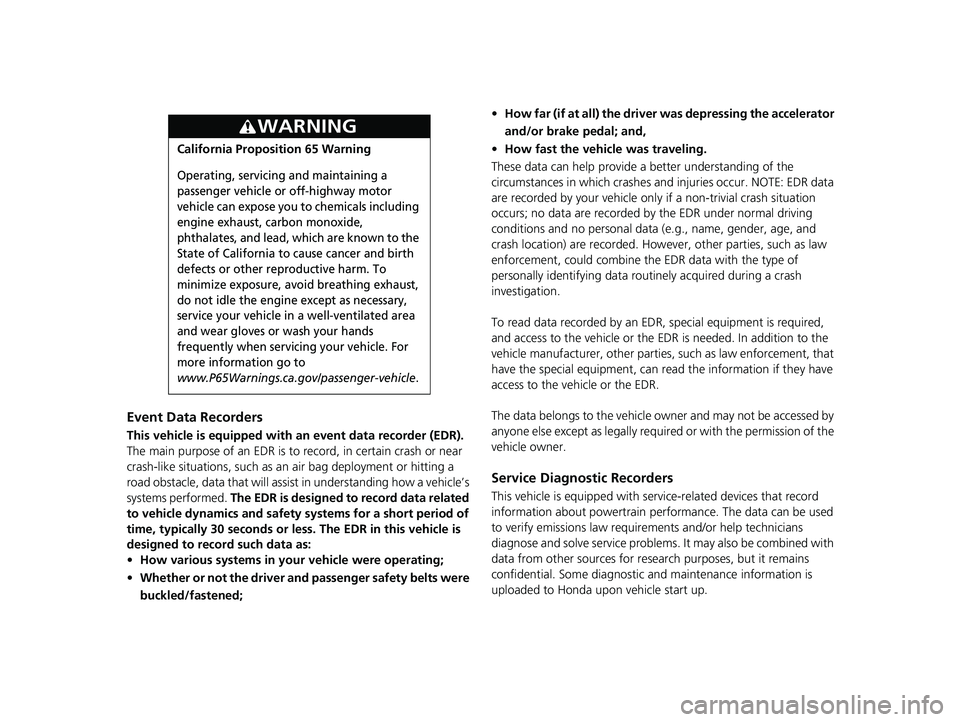
Event Data Recorders
This vehicle is equipped with an event data recorder (EDR).
The main purpose of an EDR is to record, in certain crash or near
crash-like situations, such as an air bag deployment or hitting a
road obstacle, data that will assist in understanding how a vehicle’s
systems performed. The EDR is designed to record data related
to vehicle dynamics and safety systems for a short period of
time, typically 30 seconds or le ss. The EDR in this vehicle is
designed to record such data as:
• How various systems in your vehicle were operating;
• Whether or not the driver and passenger safety belts were
buckled/fastened;
3WARNING
California Proposition 65 Warning
Operating, servicing and maintaining a
passenger vehicle or off-highway motor
vehicle can expose you to chemicals including
engine exhaust, carbon monoxide,
phthalates, and lead, which are known to the
State of California to cause cancer and birth
defects or other reproductive harm. To
minimize exposure, avoid breathing exhaust,
do not idle the engine except as necessary,
service your vehicle in a well-ventilated area
and wear gloves or wash your hands
frequently when servicing your vehicle. For
more information go to
www.P65Warnings.ca.gov/passenger-vehicle.
• How far (if at all) the driver was depressing the accelerator
and/or brake pedal; and,
• How fast the vehicle was traveling.
These data can help provide a better understanding of the
circumstances in which crashes and injuries occur. NOTE: EDR data
are recorded by your vehicle only if a non-trivial crash situation
occurs; no data are recorded by the EDR under normal driving
conditions and no personal data (e.g., name, gender, age, and
crash location) are recorded. Howeve r, other parties, such as law
enforcement, could co mbine the EDR data with the type of
personally identifying data rout inely acquired during a crash
investigation.
To read data recorded by an ED R, special equipment is required,
and access to the vehicle or the EDR is needed. In addition to the
vehicle manufacturer, other parties, such as law enforcement, that
have the special equipment, can re ad the information if they have
access to the vehicle or the EDR.
The data belongs to the vehicle ow ner and may not be accessed by
anyone else except as legally requir ed or with the permission of the
vehicle owner.
Service Diagnostic Recorders
This vehicle is equipped with se rvice-related devices that record
information about powertrain perfo rmance. The data can be used
to verify emissions law requirem ents and/or help technicians
diagnose and solve service problems. It may also be combined with
data from other sources for res earch purposes, but it remains
confidential. Some diagnostic and maintenance information is
uploaded to Honda upon vehicle start up.
19 CLARITY BEV-31TRV6200.book 0 ページ 2018年10月29日 月曜日 午前10時54分
Page 4 of 559
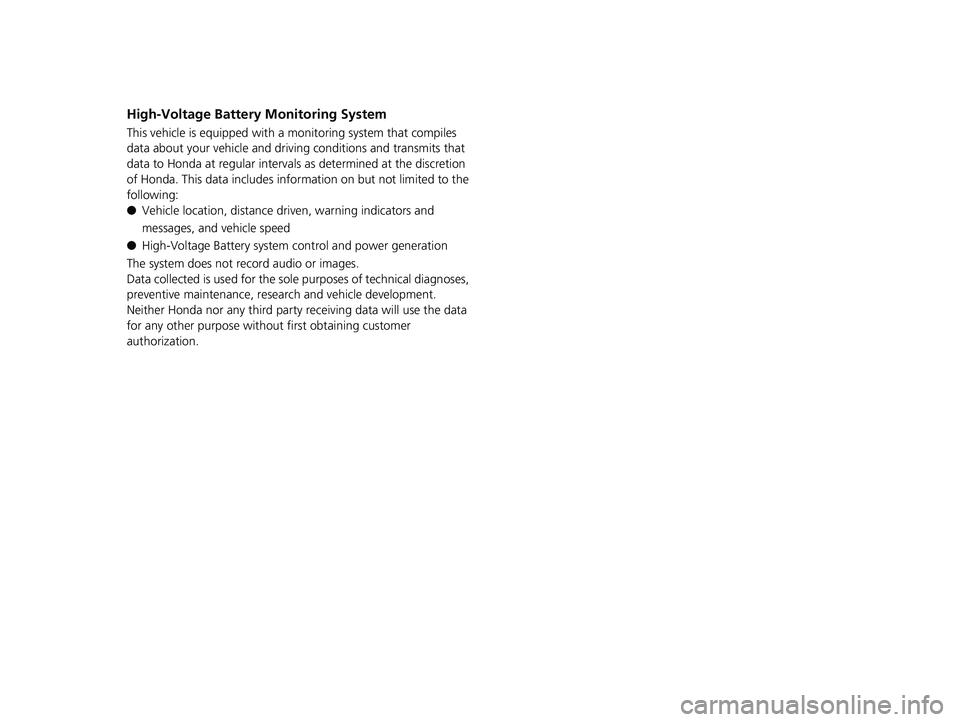
High-Voltage Battery Monitoring System
This vehicle is equipped with a monitoring system that compiles
data about your vehicle and drivin g conditions and transmits that
data to Honda at regular intervals as determined at the discretion
of Honda. This data includes information on but not limited to the
following:
● Vehicle location, distance dr iven, warning indicators and
messages, and vehicle speed
● High-Voltage Battery system control and power generation
The system does not record audio or images.
Data collected is used for the sole purposes of technical diagnoses,
preventive maintenance, resear ch and vehicle development.
Neither Honda nor any third party receiving data will use the data
for any other purpose withou t first obtaining customer
authorization.
19 CLARITY BEV-31TRV6200.book 2 ページ 2018年10月29日 月曜日 午前10時54分
Page 6 of 559
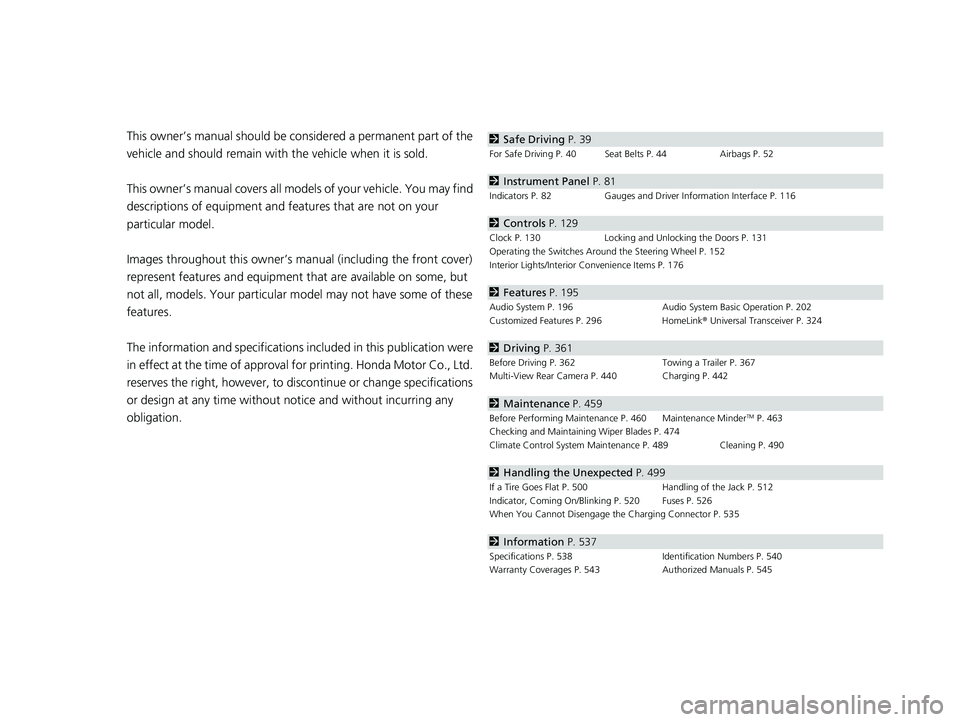
Contents
This owner’s manual should be considered a permanent part of the
vehicle and should remain with the vehicle when it is sold.
This owner’s manual covers all models of your vehicle. You may find
descriptions of equipment and features that are not on your
particular model.
Images throughout this owner’s manu al (including the front cover)
represent features and equipment that are available on some, but
not all, models. Your particular mo del may not have some of these
features.
The information and specifications in cluded in this publication were
in effect at the time of approval for printing. Honda Motor Co., Ltd.
reserves the right, however, to discontinue or change specifications
or design at any time without notice and without incurring any
obligation.2 Safe Driving P. 39
For Safe Driving P. 40 Seat Belts P. 44 Airbags P. 52
2Instrument Panel P. 81
Indicators P. 82 Gauges and Driver Information Interface P. 116
2Controls P. 129
Clock P. 130 Locking and Unlocking the Doors P. 131
Operating the Switches Ar ound the Steering Wheel P. 152
Interior Lights/Interior Convenience Items P. 176
2 Features P. 195
Audio System P. 196 Audio System Basic Operation P. 202
Customized Features P. 296 HomeLink® Universal Transceiver P. 324
2 Driving P. 361
Before Driving P. 362 Towing a Trailer P. 367
Multi-View Rear Camera P. 440 Charging P. 442
2 Maintenance P. 459
Before Performing Maintenance P. 460 Maintenance MinderTM P. 463
Checking and Maintaining Wiper Blades P. 474
Climate Control System Main tenance P. 489 Cleaning P. 490
2Handling the Unexpected P. 499
If a Tire Goes Flat P. 500 Handling of the Jack P. 512
Indicator, Coming On/Blinking P. 520 Fuses P. 526
When You Cannot Disengage the Charging Connector P. 535
2Information P. 537
Specifications P. 538 Identification Numbers P. 540
Warranty Coverages P. 543 Authorized Manuals P. 545
19 CLARITY BEV-31TRV6200.book 4 ページ 2018年10月29日 月曜日 午前10時54分
Page 7 of 559
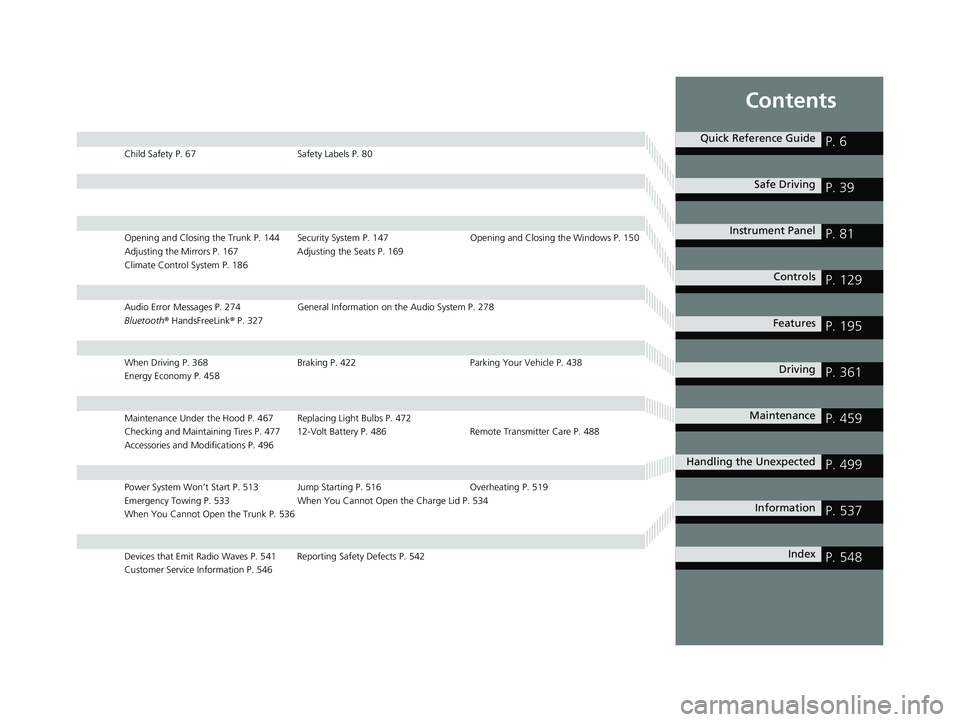
Contents
Child Safety P. 67Safety Labels P. 80
Opening and Closing the Trunk P. 144 Security System P. 147 Opening and Closing the Windows P. 150
Adjusting the Mirrors P. 167 Adjusting the Seats P. 169
Climate Control System P. 186
Audio Error Messages P. 274 General Information on the Audio System P. 278
Bluetooth ® HandsFreeLink ® P. 327
When Driving P. 368 Braking P. 422Parking Your Vehicle P. 438
Energy Economy P. 458
Maintenance Under the Hood P. 467 Replacing Light Bulbs P. 472
Checking and Maintaining Tires P. 477 12-Volt Battery P. 486 Remote Transmitter Care P. 488
Accessories and Modifications P. 496
Power System Won’t Start P. 513 Jump Starting P. 516 Overheating P. 519
Emergency Towing P. 533 When You Cannot Open the Charge Lid P. 534
When You Cannot Open the Trunk P. 536
Devices that Emit Radio Waves P. 541 Reporting Safety Defects P. 542
Customer Service Information P. 546
Quick Reference GuideP. 6
Safe DrivingP. 39
Instrument PanelP. 81
ControlsP. 129
FeaturesP. 195
DrivingP. 361
MaintenanceP. 459
Handling the UnexpectedP. 499
InformationP. 537
IndexP. 548
19 CLARITY BEV-31TRV6200.book 5 ページ 2018年10月29日 月曜日 午前10時54分
Page 12 of 559
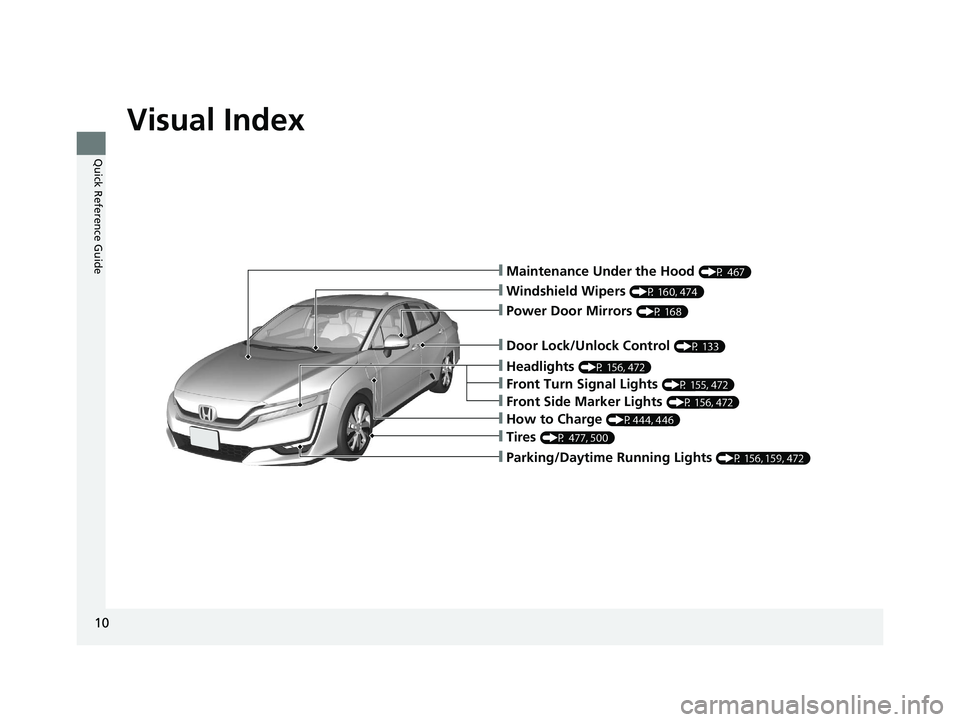
Visual Index
10
Quick Reference Guide
❙Maintenance Under the Hood (P 467)
❙Windshield Wipers (P 160, 474)
❙Tires (P 477, 500)
❙Door Lock/Unlock Control (P 133)
❙Power Door Mirrors (P 168)
❙Headlights (P 156, 472)
❙Front Turn Signal Lights (P 155, 472)
❙Parking/Daytime Running Lights (P 156, 159, 472)
❙Front Side Marker Lights (P 156, 472)
❙How to Charge (P444, 446)
19 CLARITY BEV-31TRV6200.book 10 ページ 2018年10月29日 月曜日 午前10時54分
Page 17 of 559
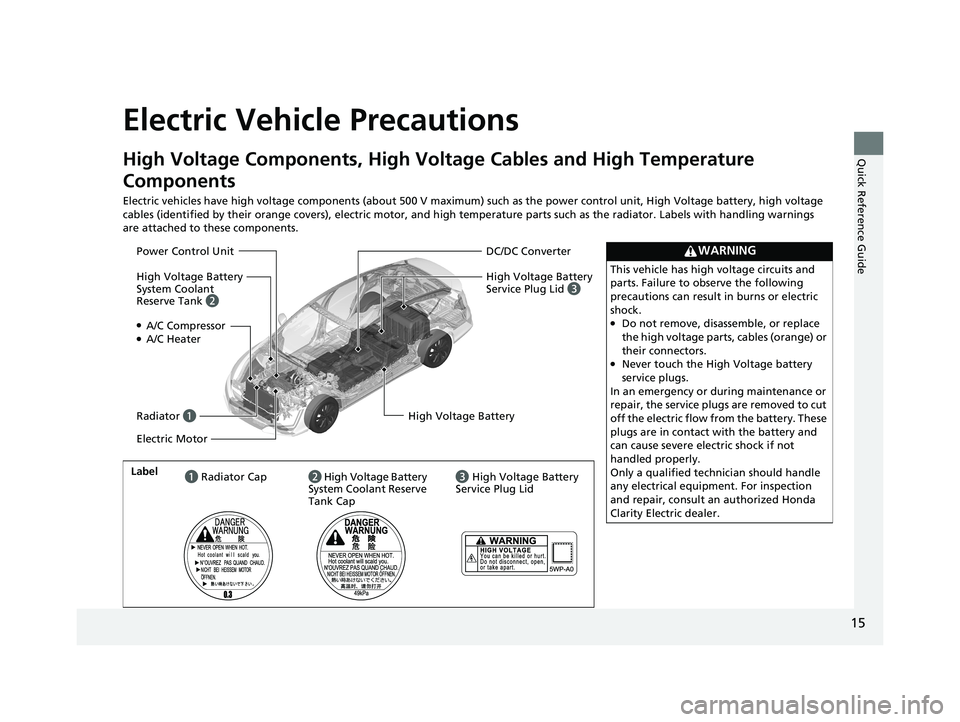
15
Quick Reference Guide
Electric Vehicle Precautions
High Voltage Components, High Voltage Cables and High Temperature
Components
Electric vehicles have high voltage components (about 500 V maximum) such as the power control unit, High Voltage battery, high voltage
cables (identified by their orange covers), electric motor, and high temperature parts such as the radiator. Labels with handli ng warnings
are attached to these components.
WARNING
This vehicle has high voltage circuits and
parts. Failure to observe the following
precautions can result in burns or electric
shock.
●Do not remove, disassemble, or replace
the high voltage parts, cables (orange) or
their connectors.
●Never touch the High Voltage battery
service plugs.
In an emergency or during maintenance or
repair, the service plugs are removed to cut
off the electric flow from the battery. These
plugs are in contact with the battery and
can cause severe electric shock if not
handled properly.
Only a qualified technician should handle
any electrical equipment. For inspection
and repair, consult an authorized Honda
Clarity Electric dealer.
DC/DC Converter
●A/C Compressor●A/C Heater
Radiator a High Voltage Battery
Label
a Radiator Cap
Power Control Unit
Electric Motor
High Voltage Battery
Service Plug Lid c
High Voltage Battery
System Coolant
Reserve Tank b
b High Voltage Battery
System Coolant Reserve
Tank Cap c
High Voltage Battery
Service Plug Lid
19 CLARITY BEV-31TRV6200.book 15 ページ 2018年10月29日 月曜日 午前10時54分
Page 19 of 559
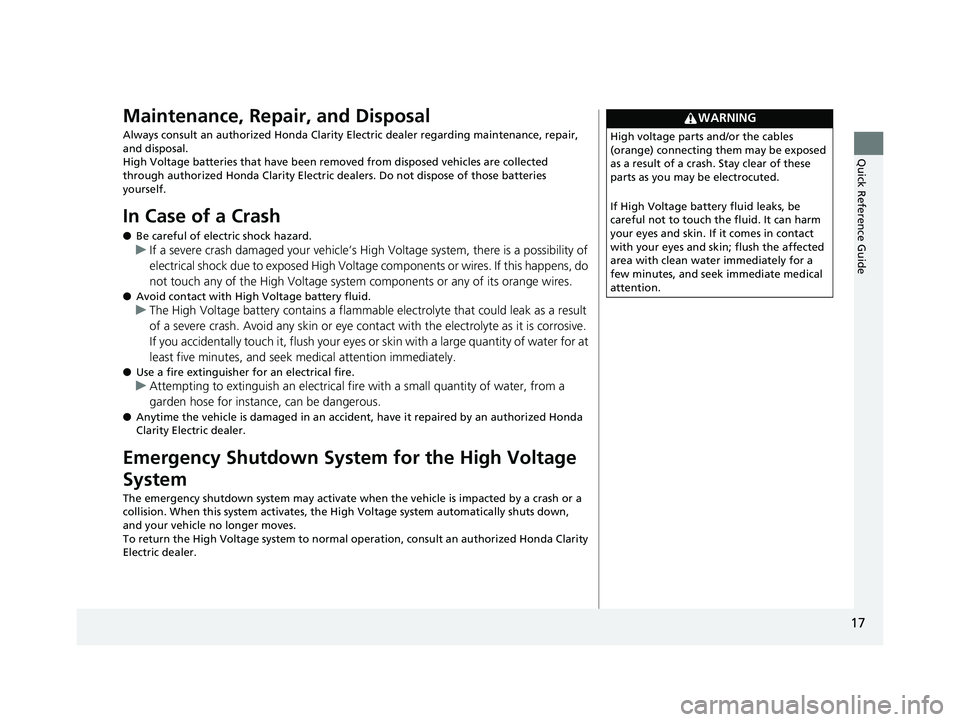
17
Quick Reference Guide
Maintenance, Repair, and Disposal
Always consult an authorized Honda Clarity Electric dealer regarding maintenance, repair,
and disposal.
High Voltage batteries that have been removed from disposed vehicles are collected
through authorized Honda Clarity Electric dealers. Do not dispose of those batteries
yourself.
In Case of a Crash
● Be careful of electric shock hazard.
uIf a severe crash damaged your vehicle’s Hi gh Voltage system, there is a possibility of
electrical shock due to exposed High Voltage components or wires. If this happens, do
not touch any of the High Vo ltage system components or any of its orange wires.
●Avoid contact with High Voltage battery fluid.
uThe High Voltage battery contains a flammabl e electrolyte that could leak as a result
of a severe crash. Avoid any skin or eye cont act with the electrolyte as it is corrosive.
If you accidentally touch it, flush your eyes or skin with a large quantity of water for at
least five minutes, and seek medical attention immediately.
● Use a fire extinguisher for an electrical fire.
uAttempting to extinguish an electrical fire with a small quantity of water, from a
garden hose for instance, can be dangerous.
● Anytime the vehicle is damaged in an accident, have it repaired by an authorized Honda
Clarity Electric dealer.
Emergency Shutdown System for the High Voltage
System
The emergency shutdown system may activate when the vehicle is impacted by a crash or a
collision. When this system activates, the High Voltage system automatically shuts down,
and your vehicle no longer moves.
To return the High Voltage syste m to normal operation, consult an authorized Honda Clarity
Electric dealer.
WARNING
High voltage parts and/or the cables
(orange) connecting them may be exposed
as a result of a crash. Stay clear of these
parts as you may be electrocuted.
If High Voltage battery fluid leaks, be
careful not to touch the fluid. It can harm
your eyes and skin. If it comes in contact
with your eyes and skin; flush the affected
area with clean water immediately for a
few minutes, and seek immediate medical
attention.
19 CLARITY BEV-31TRV6200.book 17 ページ 2018年10月29日 月曜日 午前10時54分
Page 36 of 559
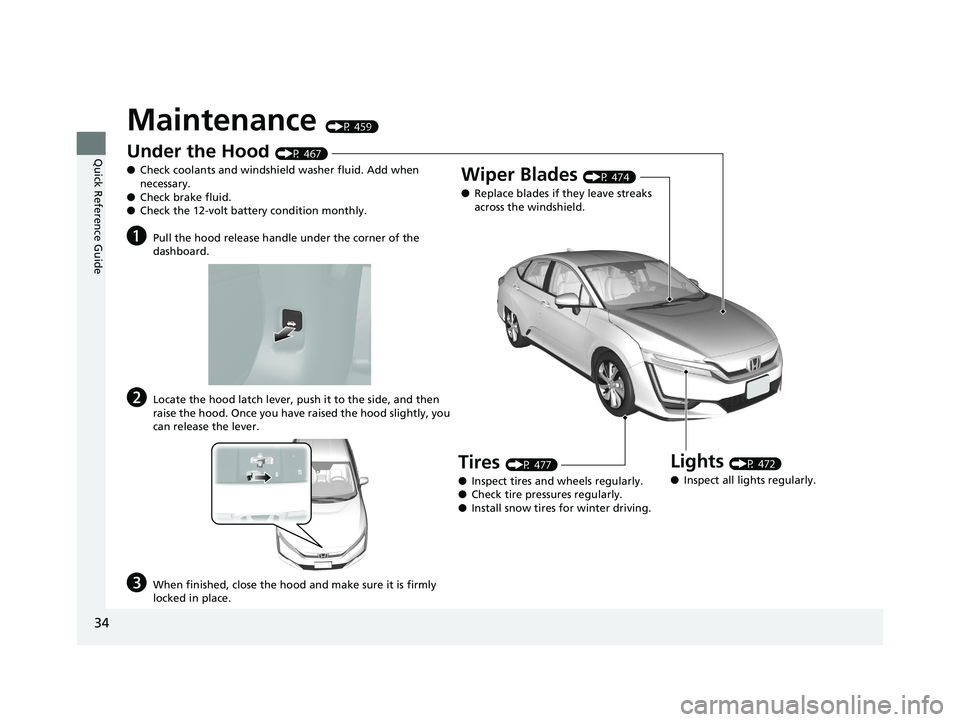
34
Quick Reference Guide
Maintenance (P 459)
Under the Hood (P 467)
● Check coolants and windshield washer fluid. Add when
necessary.
● Check brake fluid.
● Check the 12-volt battery condition monthly.
aPull the hood release handle under the corner of the
dashboard.
bLocate the hood latch lever, push it to the side, and then
raise the hood. Once you have raised the hood slightly, you
can release the lever.
cWhen finished, close the hood and make sure it is firmly
locked in place.
Lights (P 472)
● Inspect all lights regularly.
Wiper Blades (P 474)
● Replace blades if they leave streaks
across the windshield.
Tires (P 477)
● Inspect tires and wheels regularly.
● Check tire pressures regularly.
● Install snow tires for winter driving.
19 CLARITY BEV-31TRV6200.book 34 ページ 2018年10月29日 月曜日 午前10時54分